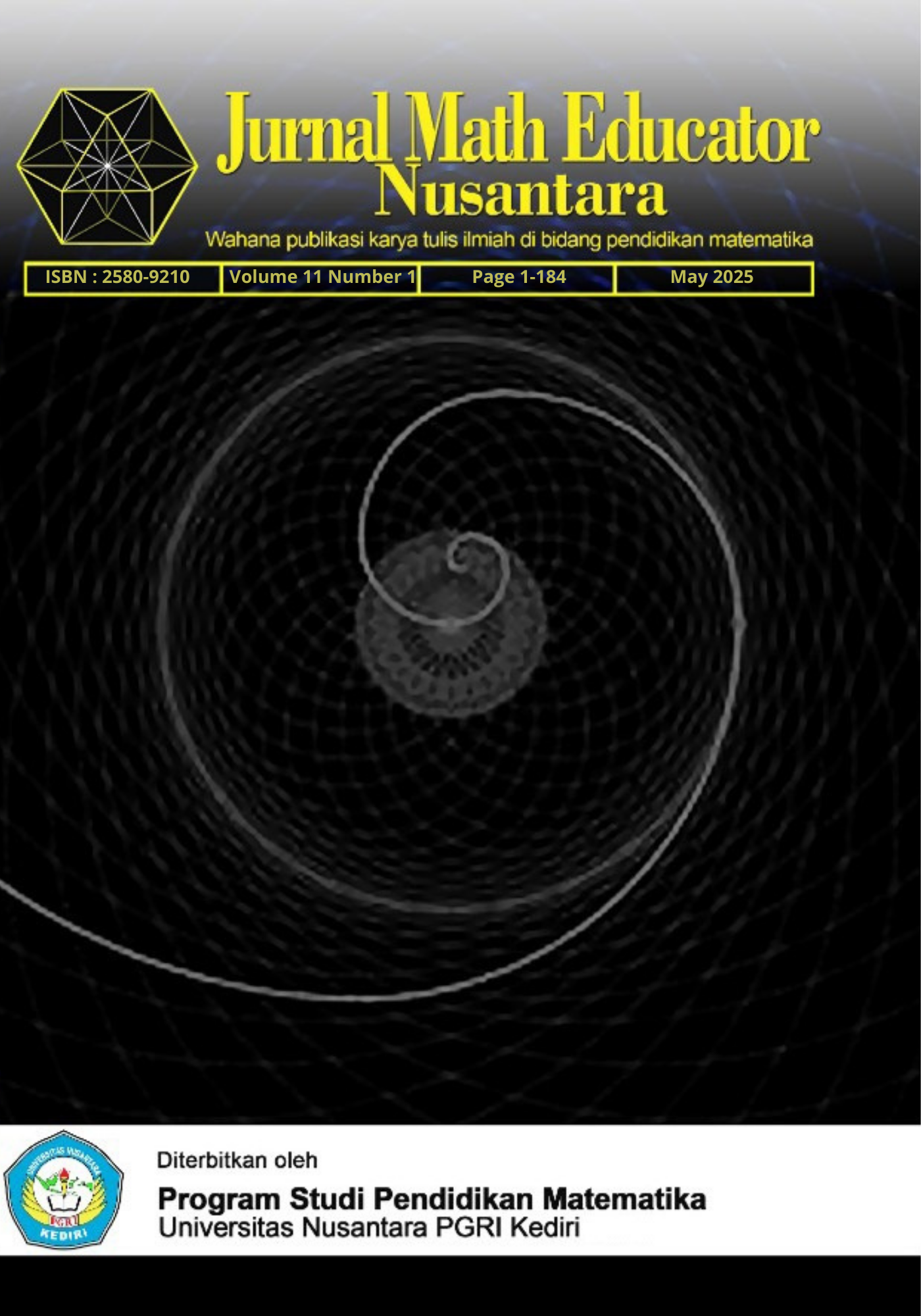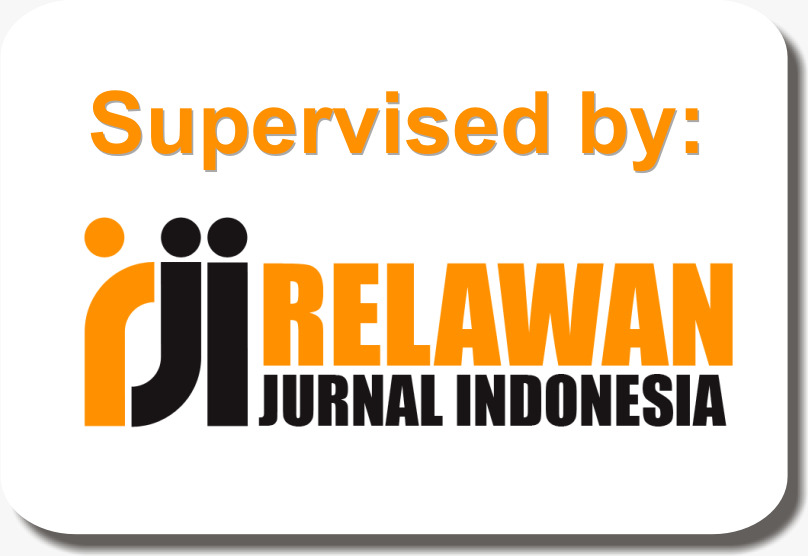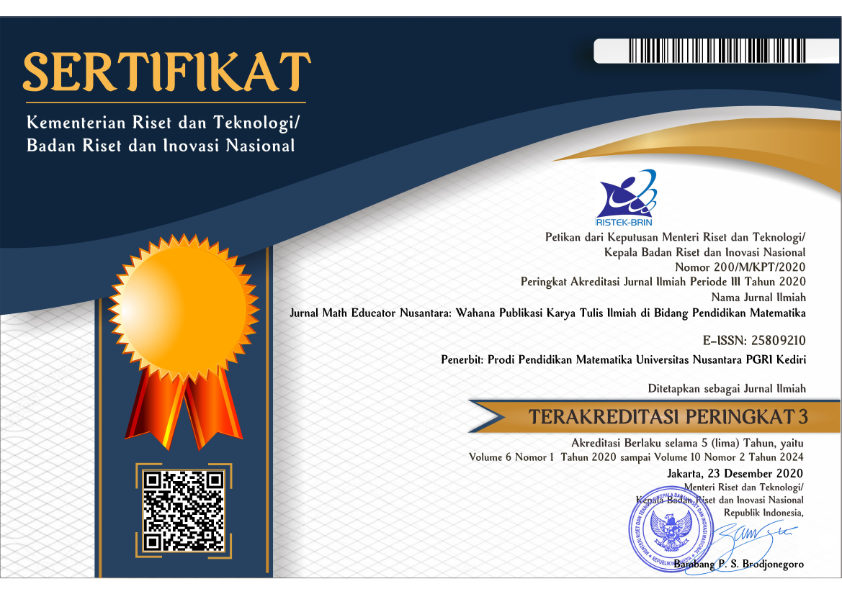Learning trajectory in mathematics education for geometry topic
DOI:
https://doi.org/10.29407/jmen.v11i1.24268Keywords:
learning trajectory, pembelajaran, matematika, geometriAbstract
Penelitian ini bertujuan untuk mengkaji learning trajectory dalam pembelajaran matematika, khususnya pada materi geometri, menggunakan metode Systematic Literature Review (SLR) dengan analisis bibliometrik melalui perangkat Vosviewer. Learning trajectory merupakan pendekatan strategis yang memetakan langkah-langkah pembelajaran secara progresif untuk mencapai pemahaman konseptual yang lebih baik. Materi geometri dipilih karena sifatnya abstrak dan memerlukan representasi visual untuk memfasilitasi pemahaman peserta didik. Metode SLR digunakan untuk menganalisis tren penelitian, teori yang mendasari, serta implementasi learning trajectory pada pembelajaran geometri. Data diambil dari artikel jurnal terindeks dalam database seperti Google Scholar, Scopus, dan Web of Science. Analisis dengan Vosviewer digunakan untuk memvisualisasikan hubungan antara konsep, kata kunci, dan topik utama yang sering muncul. Hasil analisis menunjukkan bahwa learning trajectory berperan penting dalam mendukung pemahaman geometri melalui pendekatan berbasis visualisasi, manipulasi objek, dan diskusi kolaboratif. Temuan juga mengidentifikasi tiga tema utama: (1) desain learning trajectory berbasis masalah (problem-based learning), (2) pengintegrasian teknologi dalam pembelajaran geometri, dan (3) peran asesmen formatif dalam memvalidasi proses pembelajaran. Kesimpulan dari penelitian ini menegaskan bahwa penggunaan learning trajectory yang dirancang dengan cermat dapat meningkatkan efektivitas pembelajaran geometri. Penelitian ini diharapkan dapat memberikan kontribusi bagi pendidik dan peneliti untuk meningkatkan kualitas pembelajaran matematika melalui pendekatan yang lebih terstruktur dan berbasis data.
References
Ali, S., DiPaola, D., Lee, I., Hong, J., & Breazeal, C. (2021, 2021). Exploring generative models with middle school students Conference on Human Factors in Computing Systems - Proceedings, https://doi.org/10.1145/3411764.3445226
Altche, F., & Fortelle, A. (2017, 2017). An LSTM network for highway trajectory prediction IEEE Conference on Intelligent Transportation Systems, Proceedings, ITSC, https://doi.org/10.1109/ITSC.2017.8317913
Bu, X., Dai, X., & Hou, R. (2023). Data‐driven iterative learning trajectory tracking control for wheeled mobile robot under constraint of velocity saturation. IET Cyber‐Systems and Robotics.
Can, D. (2020). Supporting Learning Trajectories for the Development of Number Concept: Digital Games. Kuramsal Eğitimbilim, 13(4), 663–684. https://doi.org/10.30831/akukeg.692165
Clara, A., Brizuela, B. M., Blanton, M., Sawrey, K., Gardiner, A. M., & Newman-owens, A. (2021). A learning trajectory in Kindergarten and first grade students' thinking of variable and use of variable notation to represent indeterminate quantities.
Clements, D. H., & Sarama, J. (2004). Engaging young children in mathematics: Standards for early childhood mathematics education. Lawrence Erlbaum Associates Publishers.
Domu, I., & Mangelep, N. O. (2020). The Development of Students' Learning Material on Arithmatic Sequence Using PMRI. Approach, 196(Ijcse), 426–432. https://doi.org/10.2991/aer.k.201124.076
Gallagher, M. A., Parsons, S. A., & Vaughn, M. (2022). Adaptive teaching in mathematics: a review of the literature. Educational Review, 74(2), 298–320. https://doi.org/10.1080/00131911.2020.1722065
Gravemeijer, K., & Cobb, P. (2006). Design research from a learning design perspective. Educational Design Research.
Hendrik, A. I., Ekowati, C. K., & Samo, D. D. (2020). Kajian Hypothetical Learning Trajectories dalam Pembelajaran Matematika di Tingkat SMP. Fraktal: Jurnal Matematika Dan Pendidikan Matematika, 1(1), 1–11. https://doi.org/10.35508/fractal.v1i1.2683
Hmelo-Silver, C. E. (2004). Problem-Based Learning: What and How Do Students Learn? Educational Psychology Review, 16(3), 235–266. https://doi.org/10.1023/B:EDPR.0000034022.16470.f3
Lantakay, C. N., Senid, P. P., Blegur, I. K. S., & Samo, D. D. (2023). Hypothetical Learning Trajectory: Bagaimana Perannya dalam Pembelajaran Matematika di Sekolah Dasar? Griya Journal of Mathematics Education and Application, 3(2), 384–393. https://doi.org/10.29303/griya.v3i2.329
Lee, M. Y., & Lee, J. E. (2021). A learning trajectory as a scaffold for pre-service teachers' noticing of students' mathematical understanding. International Journal of Science and Mathematics Education, 19(3), 539–558. https://doi.org/10.1007/s10763-020-10062-0
Litkowski, E. C., Duncan, R. J., Logan, J. A. R., & Purpura, D. J. (2020). When do preschoolers learn specific mathematics skills? Mapping the development of early numeracy knowledge. Journal of Experimental Child Psychology, 195, 104846. https://doi.org/10.1016/j.jecp.2020.104846
Liu, C., Yang, H., Fu, J., & Qian, X. (2022, 2022). Learning Trajectory-Aware Transformer for Video Super-Resolution Proceedings of the IEEE Computer Society Conference on Computer Vision and Pattern Recognition, https://doi.org/10.1109/CVPR52688.2022.00560
Morais, R., Le, V., Tran, T., Saha, B., Mansour, M., & Venkatesh, S. (2019, 2019). Learning regularity in skeleton trajectories for anomaly detection in videos Proceedings of the IEEE Computer Society Conference on Computer Vision and Pattern Recognition, https://doi.org/10.1109/CVPR.2019.01227
Mousoulides, N., & Sriraman, B. (2020). Encyclopedia of Mathematics Education. In Encyclopedia of Mathematics Education. https://doi.org/10.1007/978-94-007-4978-8
NCTM. (2000). Principles and standards for school mathematics. Author.
Nursyahidah, F., Saputro, B. A., Albab, I. U., & Aisyah, F. (2020). Pengembangan Learning Trajectory Based Instruction Materi Kerucut Menggunakan Konteks Megono Gunungan. Mosharafa: Jurnal Pendidikan Matematika, 9(1), 47–58. https://doi.org/10.31980/mosharafa.v9i1.591
Pacchiano, A., Saha, A., & Lee, J. (2023). Dueling RL: Reinforcement Learning with Trajectory Preferences. Proceedings of Machine Learning Research, 206, 6263–6289.
Putri, N. S., Sridana, N., Junaidi, J., & Hikmah, N. (2023). Pengaruh Learning Trajectory Terhadap Hasil Belajar Matematika Siswa Kelas VII SMP Negeri 2 Sakra Tahun Ajaran 2021/2022. Jurnal Ilmiah Profesi Pendidikan, 8(1), 391–396. https://doi.org/10.29303/jipp.v8i1.1189
Rich, K. M., Binkowski, T. A., Strickland, C., & Franklin, D. (2018, 2018). Decomposition: A K-8 computational thinking learning trajectory ICER 2018 - Proceedings of the 2018 ACM Conference on International Computing Education Research, https://doi.org/10.1145/3230977.3230979
Rokhmawati, L. N., Ratnaningsih, N., & Ni'mah, K. (2023). ATURAN PENJUMLAHAN DAN PERKALIAN DALAM KAIDAH PENCACAHAN. BAGAIMANAKAH DESAIN HYPOTHETICAL LEARNING TRAJECTORY BERBASIS RME? JPMI (Jurnal Pembelajaran Matematika Inovatif, 6(3), 937–950. https://doi.org/10.22460/jpmi.v6i3.17321
Sari, D. L., Fitriani, D. A., Khaeriyah, D. Z., Hartono, & Nursyahidah, F. (2022). Hypothetical Learning Trajectory pada Materi Peluang: Konteks Mainan Tradisional Ular Naga. Mosharafa: Jurnal Pendidikan Matematika, 11(2), 203–214. https://doi.org/10.31980/mosharafa.v11i2.699
Schult, J., Mahler, N., Fauth, B., & Lindner, M. A. (2022). Did students learn less during the COVID-19 pandemic? Reading and mathematics competencies before and after the first pandemic wave. School Effectiveness and School Improvement, 33(4), 544-563. https://doi.org/10.1080/09243453.2022.2061014
Simon, M. A. (1995). Reconstructing mathematics pedagogy from a constructivist perspective. Journal for Research in Mathematics Education, 26(2), 114–145. https://doi.org/10.2307/749205
Towe, M. M., & Julie, H. (2020). Developing learning trajectories with the RME of phytagorean theorem. Journal of Physics: Conference Series, 1470(1). https://doi.org/10.1088/1742-6596/1470/1/012027
Wandanu, R. H., Mujib, A., & Firmansyah. (2020). Hypothetical Learning Trajectory berbasis Pendidikan Matematika Realistik untuk Mengembangkan Kemampuan Pemecahan Masalah Matematis Siswa. Jurnal MathEducation Nusantara, 3(2), 8–16.
Wang, L., Wang, K., Pan, C., Xu, W., Aslam, N., & Hanzo, L. (2021). Multi-Agent Deep Reinforcement Learning-Based Trajectory Planning for Multi-UAV Assisted Mobile Edge Computing. IEEE Transactions on Cognitive Communications and Networking, 7(1), 73–84. https://doi.org/10.1109/TCCN.2020.3027695
Wang, S., Bao, Z., Culpepper, J. S., & Cong, G. (2021). A Survey on Trajectory Data Management, Analytics, and Learning. ACM Computing Surveys, 54(2), 1–36. https://doi.org/10.1145/3440207
Wu, H., Lyu, F., Zhou, C., Chen, J., Wang, L., & Shen, X. (2020). Optimal UAV Caching and Trajectory in Aerial-Assisted Vehicular Networks: A Learning-Based Approach. IEEE Journal on Selected Areas in Communications, 38(12), 2783–2797. https://doi.org/10.1109/JSAC.2020.3005469
Yao, Z., Yu, J., & Ding, J. (2021). Contrastive learning of graph encoder for accelerating pedestrian trajectory prediction training. IET Image Processing, 15(14), 3645–3660. https://doi.org/10.1049/ipr2.12185
Downloads
Published
Issue
Section
License
Copyright (c) 2025 Ika Muji Wahyuni, Mardiyana Mardiyana, Yuli Bangun Nursatin, Farida Nurhasanah

This work is licensed under a Creative Commons Attribution 4.0 International License.
Authors who publish with this journal agree to the following terms:
- Copyright on any article is retained by the author(s).
- The author grants the journal, the right of first publication with the work simultaneously licensed under a Creative Commons Attribution License that allows others to share the work with an acknowledgment of the work’s authorship and initial publication in this journal.
- Authors are able to enter into separate, additional contractual arrangements for the non-exclusive distribution of the journal’s published version of the work (e.g., post it to an institutional repository or publish it in a book), with an acknowledgment of its initial publication in this journal.
- Authors are permitted and encouraged to post their work online (e.g., in institutional repositories or on their website) prior to and during the submission process, as it can lead to productive exchanges, as well as earlier and greater citation of published work.
- The article and any associated published material is distributed under the Creative Commons Attribution-ShareAlike 4.0 International License
















